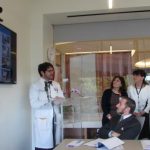
By Annie Keller
Published March 4, 2020
3D printing seems to be everywhere these days. From jewlery to car parts to robots, it doesn’t seem like there’s an industry that doesn’t use it. There’s one industry that is using the technology that most people wouldn’t guess – the medical field. 3D printing and medicine are two things that do not really seem to go together. You would be wrong, however – dental crowns, casts, prosthetic limbs, and medical devices have all been 3D printed to great effect.
The issue of tissue engineering is something that has only made achievements in the past decade or so. The ultimate dream, lab-grown or cultured tissue and organs made to fit the person who needs them, still remains a dream. While the National Institute of Health has a whole section of their site devoted to 3D printing in medicine, it thus far has few advancements related to biological material. Unlike prosthetics, there is no way that tissues can be printed out from some existing material.
However, that may change, as bioengineers at Rutgers University , funded by the NIH, may have a solution to that problem. A study published in the journal Biointerphases reveals that they have produced a “bio-ink” that can be used to build scaffolding to support growth of healthy tissues, which can eventually be used to replace damaged tissues. While far from the dream of the lab grown organ, it’s still a step forward.
The main basis of bio-ink is hyaluronic acid, a molecule found in many parts of the human body. It is commonly used in skin care products. In and of itself it is not a great material for scaffolds, as it lacks durability. The bioengineers have combined hyaluronic acid with polyethylene glycol (PEG) to make a gel that is durable enough to serve as scaffolding for other tissues.
Bio-ink only takes a day or two to develop into a usable substance, and it can be made stiffer or stickier by adjusting the ingredients. Like an ink cartridge in an ordinary printer, the researchers envision a system where the gel can be customized to represent different types of tissue.
David I. Shreiber, senior author on the paper, told Rutgers News that “Instead of an ink color for an inkjet printer, we want the mixture to have properties that are right for specific cells to multiply, differentiate, and remodel the scaffold into the appropriate tissue. ”
A similar technique is being used by researchers at UCLA . In a recent press release, a leading 3D printer manufacturer, 3D Systems has announced a partnership with biotech company, CollPlant, to investigate the possibility of eventually printing organs and other needed tissues with scaffold bioprinting processes.
So lab grown tissue isn’t there quite yet. But soon it may be a possibility.

 Previous Post
Previous Post Next Post
Next Post